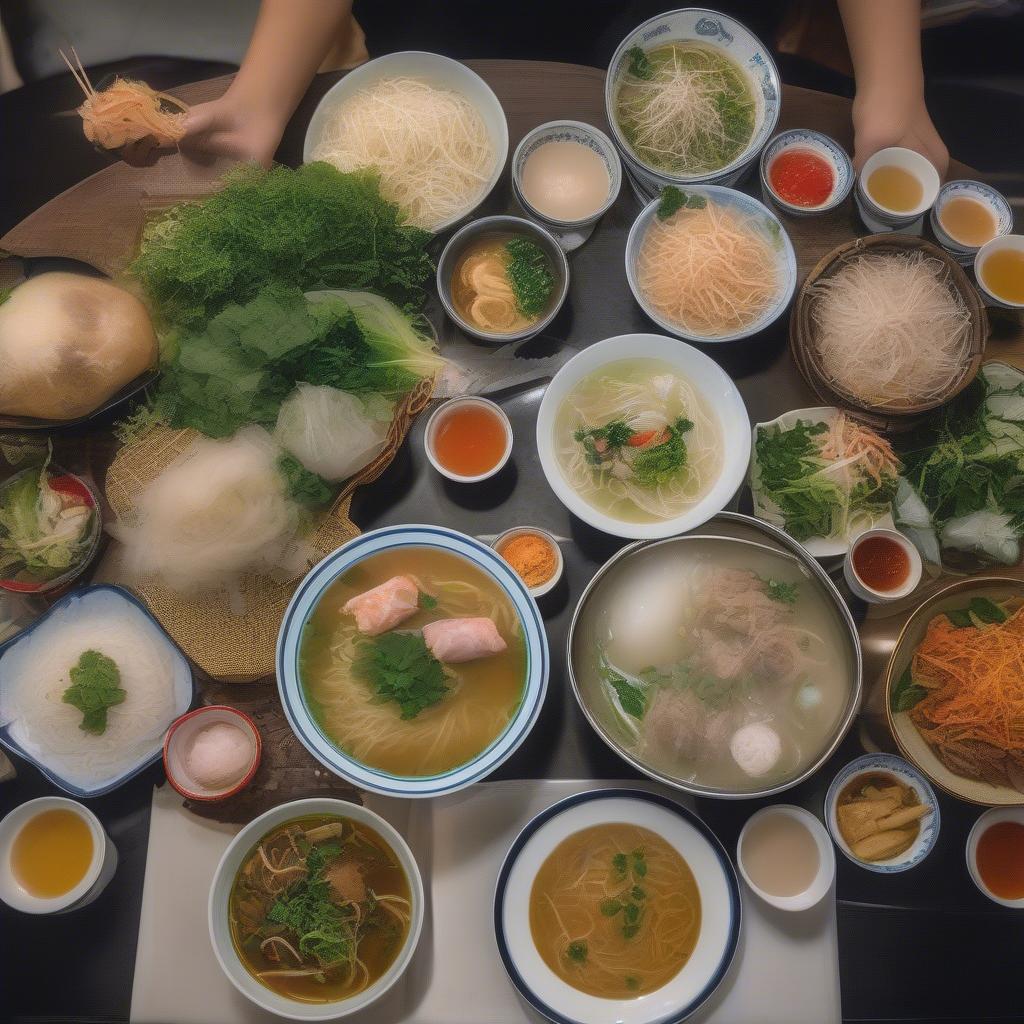Vietnamese street food: a vibrant tapestry of flavors, aromas, and cultural experiences. But whose culinary creations are these? From bustling city sidewalks to quiet countryside lanes, Vietnam’s streets are alive with vendors showcasing their skills and family recipes, passed down through generations. This article delves into the heart of Vietnamese street food, exploring its rich history, diverse regional variations, and the passionate individuals behind those irresistible dishes.
Table Content:
Decoding the Allure of Vietnamese Street Food Culture
Vietnamese street food isn’t merely about sustenance; it’s a way of life. It’s a communal experience, a chance to connect with locals, and a window into the soul of Vietnam. The vibrant energy of street food stalls, the sizzling sounds of cooking, and the fragrant steam rising from countless bowls create an atmosphere unlike any other. This dynamic food scene thrives on the dedication and creativity of countless individuals, each contributing their unique touch to Vietnam’s culinary heritage.
The foundation of Vietnamese cuisine lies in the principle of balance – a harmonious blend of sweet, sour, salty, bitter, and spicy flavors. Fresh herbs, local produce, and a variety of sauces play crucial roles in achieving this delicate equilibrium. Noodles, rice, and bánh mì (Vietnamese baguette) form the backbone of many beloved street food dishes, each offering a canvas for an explosion of tastes and textures.
A Culinary Journey Through Vietnam’s Regions
Vietnam’s diverse geography and rich history have given rise to distinct regional variations in street food. In the north, Hanoi’s culinary scene is characterized by its elegant simplicity and emphasis on fresh ingredients. Phở, the iconic noodle soup, reigns supreme, while bún chả, grilled pork with vermicelli noodles, holds a special place in the hearts of Hanoians.
 Hanoi street food vendor preparing pho and bun cha
Hanoi street food vendor preparing pho and bun cha
Central Vietnam boasts bold and complex flavors, reflecting the region’s royal heritage and proximity to the spice trade. Bún bò Huế, a spicy beef noodle soup, and bánh xèo, a crispy savory crepe, are just a few examples of the region’s culinary prowess.
Moving south, Ho Chi Minh City’s street food scene is a melting pot of influences, mirroring the city’s cosmopolitan nature. From bánh mì filled with an array of savory ingredients to gỏi cuốn, fresh spring rolls packed with herbs and shrimp, the city offers a dizzying array of choices for adventurous eaters.
 Ho Chi Minh City street food featuring banh mi and goi cuon
Ho Chi Minh City street food featuring banh mi and goi cuon
Whose Hands Craft these Culinary Masterpieces?
Behind every delicious bowl of phở or perfectly grilled bánh mì is a dedicated individual whose passion fuels Vietnam’s street food culture. These are the unsung heroes of Vietnamese cuisine – the skilled cooks, the resourceful vendors, and the families who have preserved culinary traditions for generations. They wake up before dawn to prepare fresh ingredients, meticulously crafting each dish with pride and expertise. Their stories are interwoven with the history of Vietnam, reflecting the country’s resilience, creativity, and deep connection to food.
“Vietnamese street food is more than just a job; it’s an art form,” shares Mrs. Lan, a third-generation pho vendor in Hanoi. “Each bowl of pho I make is a tribute to my family and our culinary heritage.”
 Vietnamese family preparing street food together
Vietnamese family preparing street food together
Mr. Thanh, a bánh mì vendor in Ho Chi Minh City, adds, “The secret to a great bánh mì lies in the balance of flavors and textures. It’s about using the freshest ingredients and putting your heart into every sandwich.”
Experiencing the Magic of Vietnamese Street Food
Vietnamese street food is an invitation to embark on a culinary adventure. It’s a chance to savor authentic flavors, connect with local culture, and witness the passion of the individuals who make it all possible. So, the next time you find yourself in Vietnam, venture beyond the restaurants and immerse yourself in the vibrant world of street food. Ask questions, try new things, and discover the stories behind the dishes. You might just find yourself wondering, “Whose delicious creation will I try next?”
FAQ
What is the most popular Vietnamese street food dish? Phở is arguably the most famous Vietnamese dish, both within the country and internationally.
Where can I find the best street food in Vietnam? Major cities like Hanoi, Ho Chi Minh City, and Hoi An are excellent places to explore Vietnamese street food. Look for bustling markets, street corners, and areas with high concentrations of food stalls.
Is Vietnamese street food safe to eat? Generally, Vietnamese street food is safe to eat. Look for stalls that are busy and have a high turnover of food.
Are there vegetarian options available? Yes, many vegetarian options are available, such as fresh spring rolls (gỏi cuốn), tofu dishes, and vegetable-based noodle soups. Look for dishes that feature “chay” (vegetarian) in their name or description.
How much does Vietnamese street food cost? Vietnamese street food is incredibly affordable, with most dishes costing a few dollars or less.
What are some essential Vietnamese phrases for ordering street food? Learning a few basic Vietnamese phrases, such as “xin chào” (hello), “cảm ơn” (thank you), and “bao nhiêu?” (how much?), can enhance your experience.
What are some tips for enjoying Vietnamese street food? Be adventurous, try new things, ask questions, and embrace the vibrant atmosphere. Don’t be afraid to try different sauces and condiments to customize your dish to your liking.
